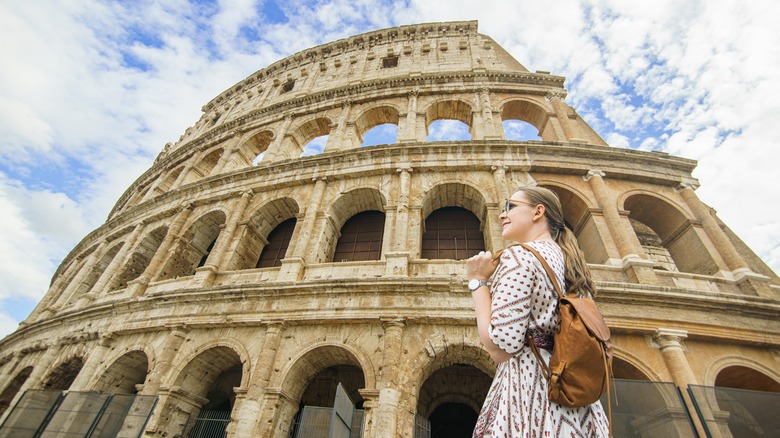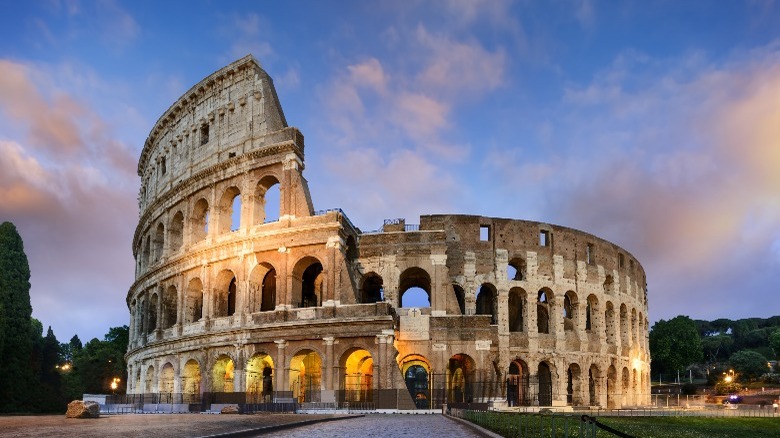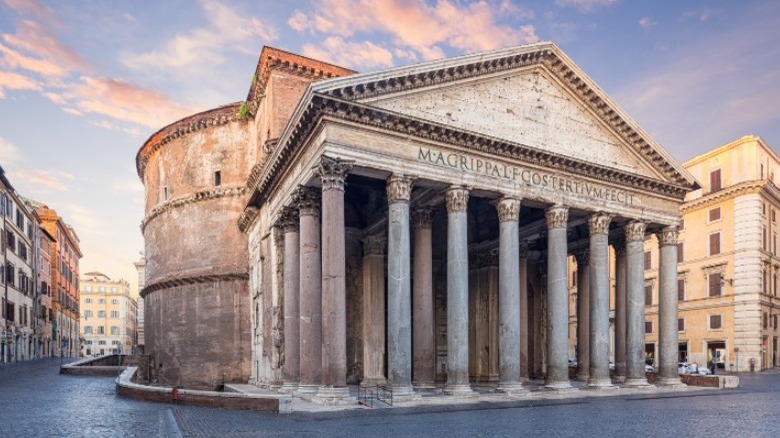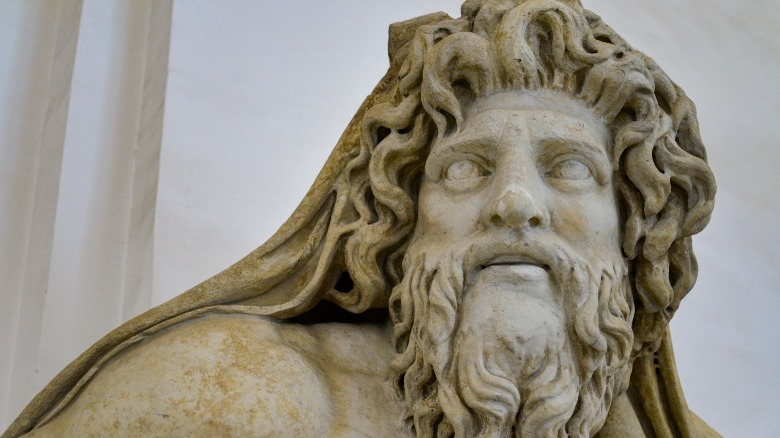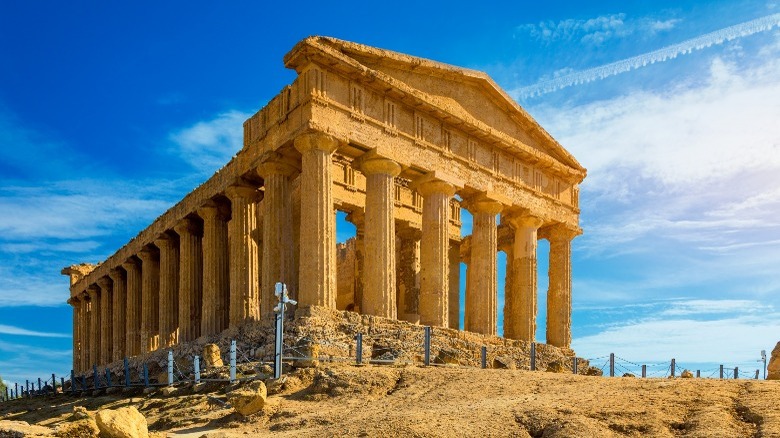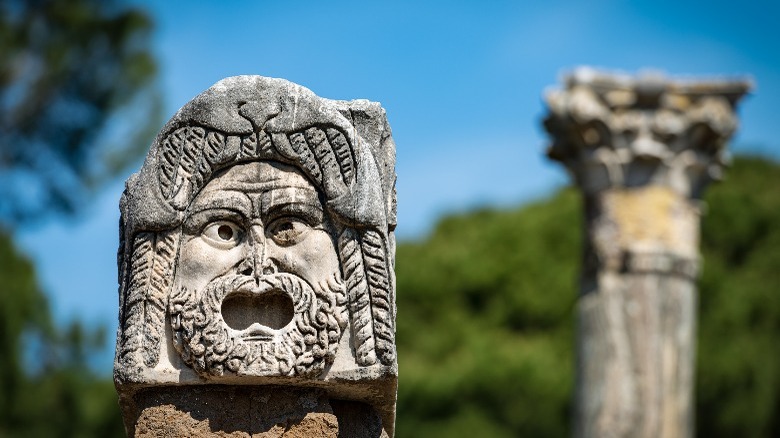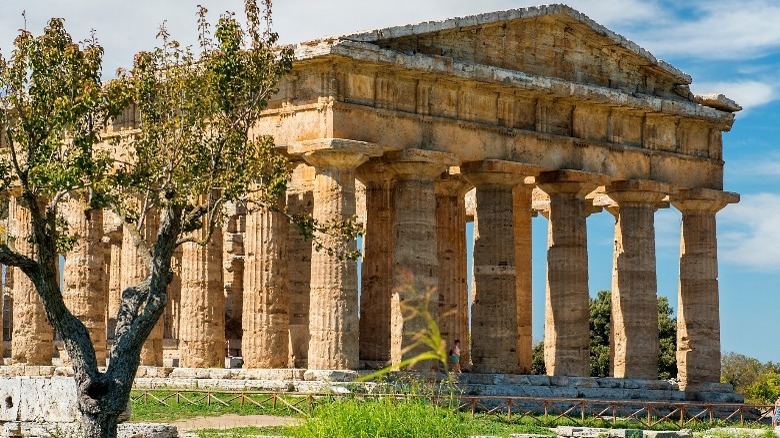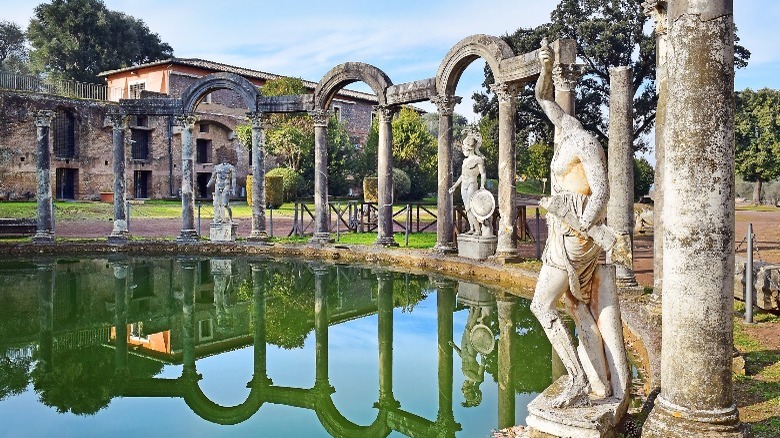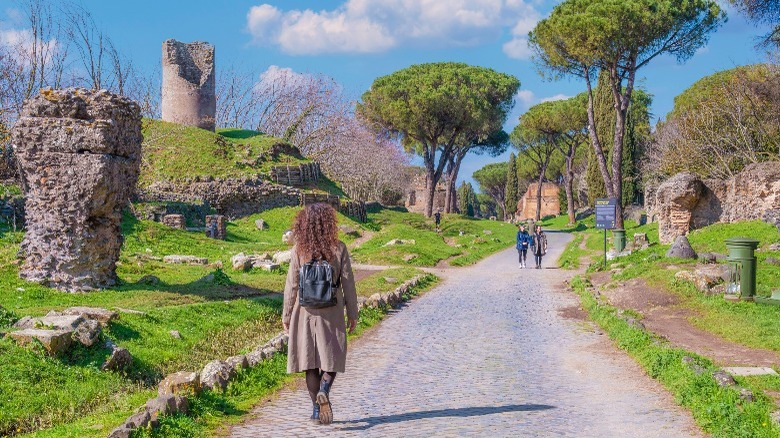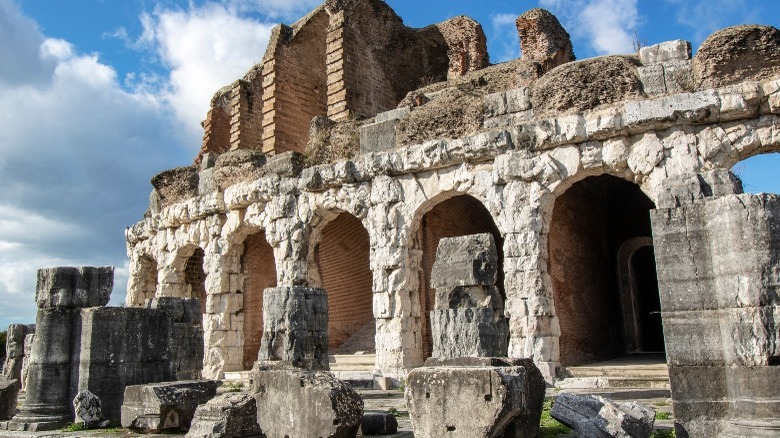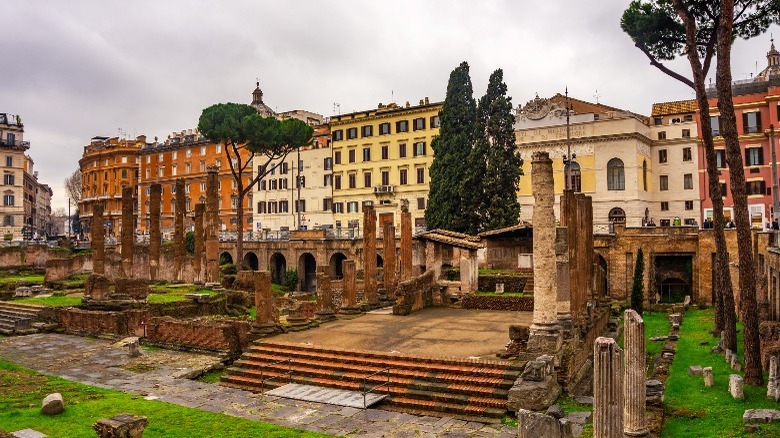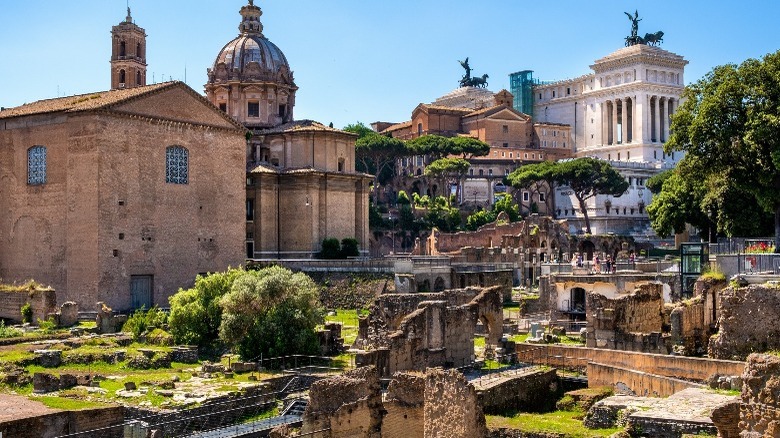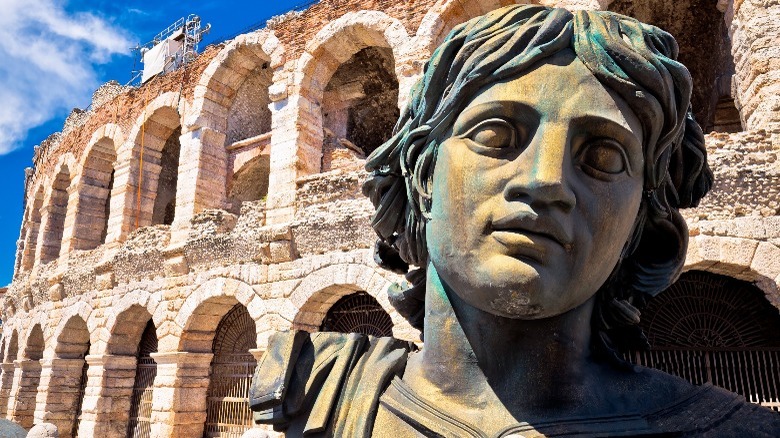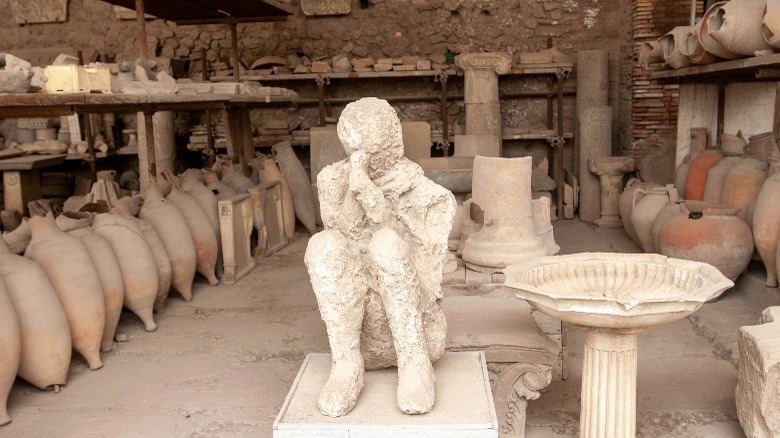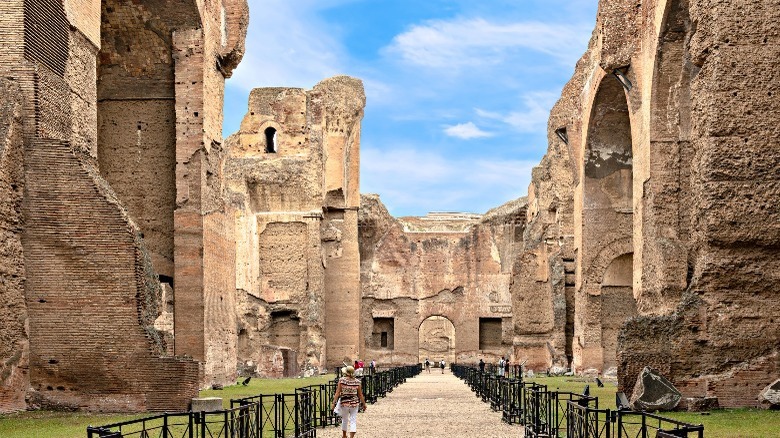The Best Sites To Visit In Italy For Ancient History Lovers
Few places on Earth can boast a history as monumental as Italy's. For over a millennium, Italy was the home to the Republic and later, the Empire of Ancient Rome, one of the most influential civilizations ever to exist, per the World History Encyclopedia. From colossal stadiums to intricate road networks and aqueducts, the ancient Romans left their mark on history and across the ancient European landscape. And, as a testament to the longevity of this ancient culture's fortitude, many of these wonderous landmarks can still be explored throughout Italy today.
Since the birth of the Republic in 509 B.C., the ancient Romans created massive cities, iconic monuments, and innovative infrastructures that spread their way across the world. However, when the Roman Empire fell in 476 A.D., many of these thriving landmarks were abandoned, left to be rediscovered over a thousand years later, starting with the Italian Renaissance in the 15th century. Today, Italy is home to 58 UNESCO World Heritage Sites, and millions of visitors flock to its idyllic countryside each year to revisit these monuments left behind by its ancient forebears. From universally recognized wonders to off-the-beaten-path archeological digs, these are the best sites to visit in Italy for ancient history lovers.
1. The Colosseum
One of the most recognizable structures of the ancient world, the Roman Colosseum was a center of entertainment in the city for over 500 years, per Civitatis Rome. Commissioned by Emperor Vespasian in 72 A.D., the Colosseum was completed during the reign of his son Titus eight years later. Over the following four centuries, the Colosseum was frequented by the Roman population for a series of events that included gladiatorial fights and other combat-based sports. The last historical use of the Colosseum was in the sixth century, at which point gladiator fights and other such events were no longer popular in Rome. For over a millennia that followed, the Colosseum was left abandoned and was subject to lootings, earthquakes, and even bombings during WWII.
At the time of its establishment, the Colosseum was a structural marvel. Made out of stone and concrete, the Colosseum differed from many other theaters of the time because it was a free-standing structure, a feat which it could accomplish thanks to its innovative building materials, per History. During its heyday, the Colosseum boasted an attendance capacity of 50,000 people. While two-thirds of the Colosseum was destroyed in the preceding years, efforts to restore the site began in the 1990s. In 2007, the Colosseum officially became one of the Seven Wonders of the Modern World, attracting approximately 9 million visitors yearly.
2. The Pantheon
Completed around 125 A.D., the Roman Pantheon is yet another iconic landmark of ancient Rome and is considered the best-preserved building from the ancient civilization, according to the World History Encyclopedia. A quintessential stop along any exploration of Rome's historical sites, the Pantheon serves as a window into the ingenuity and architectural feats of the ancient Romans.
From its white marble porch and stuccoes to the perfectly preserved interior dome, visitors to the Pantheon experience the landmark just as the ancient Romans would have almost two millennia ago. With that said, precisely what the ancient Romans used the Pantheon for is still being determined. Based on the name and design, the most likely use of the Pantheon would be that of a temple. However, the building is also known to have hosted Roman emperors' public appearances and the Roman Senate's convening.
Today the Roman Pantheon continues to occupy its location in central Rome. Nearly two thousand years after its completion, it offers one of the most significant reflections of the region's influential past and serves as a testament to the enormity and longevity of ancient Roman architecture.
3. Herculaneum
The eruption of Mt. Vesuvius in 79 A.D. is one of the most famous and deadly volcanic eruptions in history. And while Pompeii is the most widely-known victim of the disaster, the city of Herculaneum was closer to the volcano. Along with being entrenched in a thick layer of ash, the tragedy of Herculaneum was followed by a flooding cover of lava flow, something that did not occur in the nearby Pompeii. According to the World History Encyclopedia, the result of this additional molten layer is an even more enhanced preservation of the city, including organic remains.
While Herculaneum is considered even better preserved than Pompeii, the additional protection of molten rock has also made the site more difficult to excavate, and two-thirds of the site remains largely unexcavated. Still, the first-century city is a must-visit site and offers visitors a less-crowded exploration of an ancient Roman town than the more famous Pompeii, per Nomad Epicureans.
4. Valley of the Temples
Known as the Valley of Temples, The archeological area of Agrigento is a must-visit destination in Sicily for any history lover. Dating back to the sixth century B.C., Agrigento was initially founded as a Greek Colony and quickly became a dominant city in the Mediterranean and is now a protected UNESCO World Heritage Site. More famously recognized as the Valley of Temples, Agrigento received this distinction thanks to the plethora of Doric temples that riddled their way throughout the ancient city. According to Italy 4 real, Agrigento's landscapes are dotted with eight unique temples, each honoring various gods, including Juno, Demeter, Heracles, and Zeus. While all the temples are renowned for their preservation, the Temple of Concordia is the pinnacle of the site's offerings. It is considered one of the best-preserved Doric temples in the world and is even comparable to the Parthenon in Athens.
Along with touring these religious monuments, visitors to the archeological site also explore the attractions and infrastructures of late Hellenistic and Roman traditions and city planning. One of the most extensive ancient sites in Italy, and one of the greatest displays of the ancient Greek presence in the region, the Valley of Temples spans a total of 1,300 hectares across the picturesque Sicilian coast, per Italy's official tourism website. While much of the city has yet to be excavated, the site's must-see attractions include its eponymous rows of temples and one of the best-preserved examples of Doric architecture worldwide.
5. Ostia Antica
Initially founded around 620 B.C., Ostia thrived as a small community at the mouth of the Tiber River until it was conquered by Rome around 400 B.C. From there, Ostia became a naval base for Rome's conquests, and by 150 A.D., it served as a commercial center and seaport after Rome had dominated the Mediterranean, per Rick Steves' Europe. Remnants of the town's militaristic functions are found throughout the site, including a rectangular fort typical in Roman military towns.
Following the city's conversion into a seaport, Ostia Antica entered a period of prosperity, starting in the second century A.D., according to the Ostia Antica website. Becoming one of Rome's primary commercial harbors, Ostia became a wealthy community and developed an infrastructure capable of housing an estimated 50,000 inhabitants. During this time, the city underwent extensive renovations, including restructuring its forum and adding a bathhouse, guild seats, and temples, the remains of which can still be explored by visitors today.
Ostia began to decline as a seaport city in the mid-third century when much of the region's commercial trade moved to the nearby town of Porto. And, when the Roman Empire fell in the sixth century, Ostia was wholly abandoned. Today, Ostia Antica is a unique preservation of an ancient Roman seaport and is heavily under-trafficked compared to similar attractions.
6. Paestum
Founded in the seventh century B.C., Paestum is an archeological site that passed between cultures for nearly four centuries and combines influences by the Greeks, Lucanians, and Romans, per World History Encyclopedia. First established during the second wave of Greek colonization, the city's original name was Poseidonia, in honor of Poseidon. Chosen for its convenient location along Italy's eastern coast and the surrounding fertile plains, Poseidonia quickly grew into a prosperous seaport and expanded to include military fortifications, a large agora, and several prominent temples dedicated to various gods, including Hera and Athena.
In the fourth century B.C. Poseidonia was conquered by the Lucanians, who occupied the city for over a century before control of the city again changed hands when Rome conquered the area in 273 B.C. Under Roman rule, Poseidonia became known as Paestum and continued to thrive for a short time. However, due to a combination of factors, Paestum slowly shrank into obscurity, starting around 133 B.C.
Today, Paestum is one of Italy's most famous archeological sites for its blend of Greek, Lucanian, and Roman influences. In addition, the site is known for its frescoes, ceramics, artifacts, and three of the best-preserved Doric Temples in the world, per Live Salerno.
7. Villa Adriana
Designated as a UNESCO World Heritage Site in 1999, Villa Adriana was constructed by the Roman Emperor Hadrian between 117 and 138 A.D. and is one of the most remarkable displays of ancient Roman architecture, combining the traditions of the ancient Romans, Greeks, and Egyptians. Located in Tivoli, only a short drive from Rome, Villa Adriana was designed to be an 'ideal city' and served as a countryside retreat for the emperor (per UNESCO).
The villa occupied over 120 hectares of the Tiburtine Hills and was home to an extensive complex of buildings reflective of an ancient Roman city. Today, visitors to Adriana Villa are welcomed to the archeological site to explore the remains of over 30 buildings, including a Greek Theatre, the Imperial Palace, the public baths, and much more. Also available for visitors to explore are the lavish gardens that Hadrian himself would have once walked, complete with a luxurious reflective pool.
Following Hadrian's death, Villa Adriana was neglected for over a millennium and wasn't rediscovered until 1461. Since then, the villa has been an influential inspiration for architectural styles ranging from the Renaissance and Baroque styles to modern architectural techniques. It is a must-visit destination for history lovers and architecture enthusiasts and provides an inside glimpse at the opulent lifestyle of one of Rome's most celebrated emperors.
8. The Appian Way
Ancient Rome is known for its elaborate road network that spanned Europe. In fact, much of the ancient civilization's success can largely be attributed to their innovative transportation routes, which continue to serve as the basis of our road networks today. Still, while Roman roads spanned for over 50,000 miles, according to Vita Romae, the network had to start somewhere. And that somewhere was the Appian Way.
First built in 312 B.C., the Appian Way was the first and most used road in the Roman road network, per Britannica. At first, it spanned 132 miles and connected Rome to the ancient city of Capua. Then, the road was extended an additional 230 miles to Brundisium, and by 244 B.C., the Appian Way provided travelers with a reliable, flat road connecting Rome to Italy's south coast.
While many portions of the highway are still intact today, the best spot to explore this exquisite piece of history is at the Parco dell'Appia Antica. This regional park protects the first ten miles of the road, per Walks of Italy. Here, visitors can walk (or bike) the Appian Way as they retrace the footsteps of the ancient Romans while passing by picturesque landscapes and historical landmarks.
9. Campanian Amphitheater of Capua
Located along the Via Appia, Capua was one of the most important and extensive cities in the ancient Roman Empire, according to World Heritage Journeys. And, while the medieval town of Santa Maria Capua Vetere was built overtop the site of the old city, several remnants of ancient Capua can still be explored throughout the town. The most prominent and famous of these ancient sites is the Amphitheater Campano, the second largest amphitheater of the time, only behind the Colosseum in Rome.
The second amphitheater to be built on the site, the Campania Amphitheatre is believed to have once been able to host 60,000 attendants. However, this theater was completed in 138 A.D., according to History Hit, and was built atop the ruins of a more ancient arena which served as the dramatic backdrop to the Spartacus Revolt between 73 and 71 B.C. Visitors to the complex today are invited to explore the remnants of the monumental amphitheater, the old gladiator school, and the Gladiator Museum.
10. Area Sacra di Largo Argentina
Home to the oldest temples of Rome, the Area Sacra di Largo Argentina is a unique archeological site in Rome. It was only rediscovered accidentally when construction work on a nearby building unveiled it between 1926 and 1930, per Civitatis Rome. Following the site's discovery, additional archeological digs revealed four temples, the oldest of which dates back to the first half of the third century B.C., according to History Hit. However, it is unknown to which gods the temples were built to honor, so they are distinguished as Temples A, B, C, and D.
Other sites within the Area Sacra include the Theatre of Pompey and the Curia of Pompey. The Curia of Pompey is of particular interest to history buffs as the convening area for the Senate at which Julius Caesar was assassinated in 44 B.C. And, if the region's historical relevance wasn't enough to entice you to this small archeological site, then the attraction's feline residence may be. Today, the Area Sacra di Largo Argentina is home to hundreds of stray cats protected by the city's laws, making it a fantastic attraction for history buffs and cat lovers alike.
11. Roman Forum
Located at the very center of ancient Rome, the Roman Forum served as a popular marketplace and social hotspot for the ancient citizens and dates back to the very beginning of Roman society, in the seventh century B.C. According to Rome.us, the first historical use of the forum was as a neutral space for meetings involving the legendary Roman founder Romulus, who ruled over Palatine Hill, and his rival Titus Tatius who led over the nearby Capitoline Hill. The forum played an essential role in forming an alliance between the two sides, which would later expand Rome through both regions. Throughout the history of the ancient civilization, the Roman Forum continued to serve as a popular social meeting space located at the city's center.
By 500 B.C., the Roman Forum began to host several public events, including elections, gladiator fights, educational events, and even general social gatherings and public meetings, per History. By the first century B.C., the forum experienced massive expansion and was often overcrowded, which led both Julius Caesar and Augustus to create additional forums towards the original's outskirts. Today the Roman Forum continues to serve as a tourist hotspot in the city's center and attracts over 4.5 million visitors yearly. Guests to the site revisit the heart of the ancient community as they explore the remains of the forum's several temples and monuments, including the Arch of Titus and the Senate House.
12. Arena di Verona
Rounding out the trifecta of Rome's monumental arenas, the Arena di Verona was the third largest amphitheater of its time, lesser in size than only the Colosseum and the Campania Amphitheater, per History Hit. Constructed in the first century A.D., the Arena di Verona was an impressive feat of architecture, consisted of three elliptical rings, and could host up to 30,000 attendants.
Like many other theatres of the time, the Arena di Verona was left mainly abandoned following the fall of the Roman Empire. A series of natural disasters and medieval pillages devastated much of the arena, especially along the first row of elliptical rings, which remain in disrepair today. Despite this, the Arena di Verona is one of the best-preserved amphitheaters of the time and is the only of Rome's three largest theatres still hosting events today. Capable of seating 22,000 modern-day attendants, the Arena di Verona is a fantastic site for enjoying an opera or open-aired performance in the same setting and traditions as the ancient Romans.
13. Pompeii
When Mount Vesuvius erupted in 79 A.D., it blanketed Pompeii and surrounding cities with at least 19 feet of thick volcanic ash. Submerged for over a millennium, the ruins of Pompeii were rediscovered in the 17th century and were found to be perfectly preserved by the ash, per Britannica. The city's public buildings, iconic monuments, and even its terrified residents have been frozen in time and offer a unique insight into the lives of the city's ancient occupants.
According to History, Pompeii was founded as an ancient Greek colony in the eighth century B.C. However, the city was conquered by Rome in the second century B.C. and quickly grew into a popular resort town on the Italian coast. By the time Mount Vesuvius erupted, it was the largest and most wealthy city to be destroyed and was home to many monuments from both Hellenistic and Roman times, which were perfectly preserved by the disaster. Today, visitors to the site explore the city's tragic ending as they tour the remains of the frozen citizens, frescoes, and architecture that once thrived in the region.
14. Baths of Caracalla
Public baths, or thermae, played an essential role in Roman society and were present in nearly all cities of the Roman Empire, per World History Encyclopedia. And while these baths were known as a destination of leisurely pastime, none were quite as opulent as the Baths of Caracalla. Constructed between 212 and 216 A.D., the Baths of Caracalla was one of the most extensive complexes of its kind and were commissioned by the emperor himself, Marcus Aurelius Antoninus.
According to Civitatis Rome, the baths were famous amongst Rome's esteemed citizens for over three centuries, at which point invading barbarians destroyed the city's aqueducts. Still, within that time, Romans of all statuses frequented the facilities, which included public baths, a library, exercise spaces, gardens, and even a temple devoted to Mithras and other divinities. While a 9th-century earthquake devastated many of the complexes, the baths are still relatively preserved. Today, visitors are invited to marvel at the majesty of the thermal complex once visited by all the notable Roman figures of the time.
